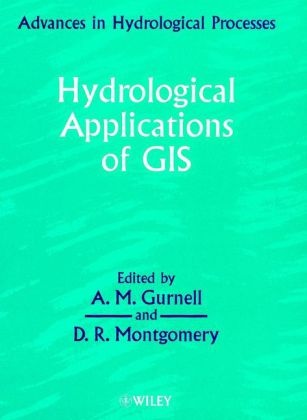Read more
Zusatztext "This book will serve as a benchmark registering process in knowledge of hydrological applications of GIS." (Hydrological Processes! 15 December 2001)"...a timely book which can be read with benefit..." (The Geographical Journal! March 2002) Informationen zum Autor A. M. Gurnell, Professor of Physical Geography. Her research interests are at the interface between hydrology, geomorphology and plant ecology, with particular emphasis on the morphodynamics and sustainable management of rivers and their margins. Her current research is pursuing three main research themes: (i) interactions between vegetation and fluvial processes; (ii) the hydroecological characteristics of urban rivers; (iii) improving the science underpinning river restoration. Klappentext Over the last two decades the dramatic increase in the computer power available to the hydrologist has led to significant developments in the way that hydrological research and operations are conducted. This collection of papers focuses on one area of such developments, the application of GIS to the solution of hydrological problems. The included papers consider or illustrate some of the key issues relevant to hydrological applications of GIS in the late 1990s. It provides papers which consider the technical and ethical ramifications of data quality and of increasing spatial resolution; issues associated with the development of multi-disiplinary, multi-use databases; and problems associated with the derivation of hydrologically-useful information from high resolution digital elevation models. It provides examples of the use of distributed hydrological models within GIS applications and it also includes hydrological applications of GIS at a range of spatial scales. These are based upon the integration of varied data sources, including historical and contemporary maps, air photographs, satellite imagery and point data from hydrological net works. This book is of particular interest to undergraduates and postgraduate students in GIS, Geography, Environmental Sciences, Earth Sciences and Environmental Engineering as well as researchers in Hydrology and Hydrogeomorphology and professionals in the public sector and commerce. Zusammenfassung This book deals with the technical problems encountered in hydrological applications of GIS, at scales ranging from the catchment to short river reaches and on a wide range of hydrological processes in both pure and applied contexts. Inhaltsverzeichnis Introduction: Hydrological Application of GIS; HYP, Vol. 12 (6); p. 821-824 A. Gurnell and D. Montgomery 1 Putting water in its place: a perspective on GIS in hydrology and water management; HYP, Vol. 12 (6); p. 823-834 M. J. Clark 2 Data and databases for decision support; HYP, Vol. 12 (6); p. 835-842 A. M. Roberts and R. V. Moore 3 The treatment of flat areas and depressions in automated drainage analysis of raster digital elevation models; HYP, Vol. 12 (6); p. 843-856 L. W. Martz and J. Garbrecht 4 A phenomenon-based approach to upslope contributing area and depressions in DEMs; HYP, Vol. 12 (6), p. 857-872 W. Rieger 5 Large scale distributed modelling and the utility of detailed ground data HYP. Vol. 12 (6): p. 873-888 F. G. R. Watson, R. B. Grayson, R. A. Vertessy and T. A. McMahon 6 Application of a GIS-based distributed hydrology model for prediction of forest harvest effects on peak streamflow in the Pacific Northwest; HYP, Vol. 12 (6); p. 889-904 P. Storck, L. Bowling, P. Wetherbee and D. Lettenmaier 7 Modelling runoff and sediment transport in catchments using GIS; HYP, Vol. 12 (6); p. 905-922 A. P. J. de Roo 8 Deciphering large landslides: linking hydrologic, groundwater, and slope-sta...
List of contents
Introduction: Hydrological Application of GIS; HYP, Vol. 12 (6); p. 821-824
A. Gurnell and D. Montgomery
1 Putting water in its place: a perspective on GIS in hydrology and water management; HYP, Vol. 12 (6); p. 823-834
M. J. Clark
2 Data and databases for decision support; HYP, Vol. 12 (6); p. 835-842
A. M. Roberts and R. V. Moore
3 The treatment of flat areas and depressions in automated drainage analysis of raster digital elevation models; HYP, Vol. 12 (6); p. 843-856
L. W. Martz and J. Garbrecht
4 A phenomenon-based approach to upslope contributing area and depressions in DEMs; HYP, Vol. 12 (6), p. 857-872
W. Rieger
5 Large scale distributed modelling and the utility of detailed ground data HYP. Vol. 12 (6): p. 873-888
F. G. R. Watson, R. B. Grayson, R. A. Vertessy and T. A. McMahon
6 Application of a GIS-based distributed hydrology model for prediction of forest harvest effects on peak streamflow in the Pacific Northwest; HYP, Vol. 12 (6); p. 889-904
P. Storck, L. Bowling, P. Wetherbee and D. Lettenmaier
7 Modelling runoff and sediment transport in catchments using GIS; HYP, Vol. 12 (6); p. 905-922
A. P. J. de Roo
8 Deciphering large landslides: linking hydrologic, groundwater, and slope-stability models through GIS; HYP, Vol. 12 (6); p. 924-942
D. J. Miller and J. Sias
9 Regional test of a model for shallow landsliding; HYP, Vol. 12 (6); 943-956
D. R. Montgomery, K. Sullivan and H. Greenberg
10 Regional-scale assessment of non-point source groundwater contamination; HYP, Vol. 12 (6), p. 957-966
K. Loague and D. L. Corwin
11 Synoptic views of sediment plumes and coastal geography of the Santa Barbara Channel, California; HYP, Vol. 12 (6); p. 967-980
L. A. K. Mertes, M. Hickman, B. Waltenberger, A. L. Bortman, E. Inlander, C. McKenzie and J. Dvorsky
12 Morphological and ecological change on a meander bend: the role of hydrological processes and the application of GIS; HYP, Vol. 12 (6); p. 981-993
A. M. Gurnell, M. Bickerton, P. G. Angold, D. Bell, I. Morrissey, G. E. Petts and J. Sadler
Index
Report
"This book will serve as a benchmark registering process in knowledge of hydrological applications of GIS." (Hydrological Processes, 15 December 2001)
"...a timely book which can be read with benefit..." (The Geographical Journal, March 2002)

